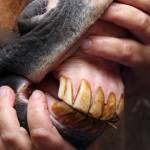Finding a Horse’s Age: Can the Teeth Tell the Tale?

“Long in the tooth” is an expression borrowed from the horse world, meaning an older horse has much longer teeth than a youngster. While it’s not difficult to see the difference in the dental array of, say, a two-year-old filly and a mare in her mid-twenties, determining the exact age of a particular horse by relying strictly on the appearance of its teeth is more of an art than a science.
The teeth of a mature horse are continuously worn away as they encounter roughage, soil, and debris. To offset this loss, the teeth slowly advance from the jawbone at a rate that roughly matches the wear. As the horse ages, various grooves and marks on the surfaces of teeth appear, change, and wear away in a predictable pattern. However, diet, dental care, injuries, disease, environment, breed, and other factors influence the appearance of the teeth so that it becomes increasing difficult to glance at the teeth and be absolutely certain about the horse’s exact age.
Assuming you are familiar with the common marks of advancing dentition in horses, it’s probably best to make an estimate such as, “The appearance of this horse’s teeth indicates he is somewhere in the range of 13 to 17 years old.” This range, coupled with an examination of general health and soundness, will give a general idea of how old the horse is and what level of work he can be expected to do.
More ideas on how to judge a horse’s age can be found in the “Official Guide for Determining the Age of the Horse.” This publication is available from the American Association of Equine Practitioners.








